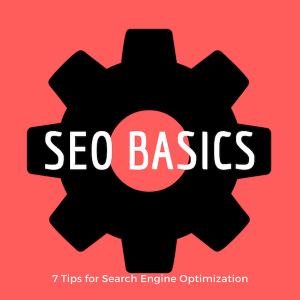7 Tips for Great Search Engine Optimization
 Search Engine Optimization can seem daunting at first. If you’re not familiar with the steps or the terms, learning about SEO can feel out of reach. Search Engine Optimization is an important step in making sure your content is seen by the people who are looking for it. Here are my seven tips for making sure you’re not hurting yourself by ignoring SEO:
Search Engine Optimization can seem daunting at first. If you’re not familiar with the steps or the terms, learning about SEO can feel out of reach. Search Engine Optimization is an important step in making sure your content is seen by the people who are looking for it. Here are my seven tips for making sure you’re not hurting yourself by ignoring SEO:
1. Content is the most important part of your website.
If your blog posts are difficult to read, or your message doesn’t make sense, people will not stay on your website very long. Google can track how much time people spend on websites they find through Google. If people leave your page only seconds after clicking on it, Google will take that to mean that your content isn’t what people are looking for. The best way to keep people on your website is to have valuable, easy to understand content that is relevant to your keywords.
2. Build Mobile-first content.
Most people use smartphones as their primary method of browsing the internet. If your website isn’t optimized for mobile phones, it will look bad and people will leave. In many cases, having a mobile website is more important than having a desktop site. Mobile-friendly websites should be clean, streamlined, and have text large enough to read, and all of these are good design elements for desktop sites too!
3. Optimize your photos.
Pictures that are unnecessarily large can make your webpage load slower. This isn’t good for people trying to get to your website, or your search engine rankings. To make sure your photos aren’t slowing down your website, try to keep pictures between 150 – 200 kb large.
4. Make 301 Redirects.
If you change the address to a page, make sure you set up a 301 redirect from the old link to the new one. If other websites or pages have linked to the old address, Google may begin to see it as a broken link. Making sure that people can reach your website is one of the most important parts of SEO.
5. Use Alt tags for images.
Alt tags are text descriptions of images that you use on your page. Search engines recognize alt tags when looking at pages, and it will show that your page is professional. Alt tags and image descriptions also help people who use screen readers or who have differences in sight ability.
6. Add External Links.
If you start a brand new blog or website, one of the first things you should do is link to it on social media. Links help search engines discover your website, and that allows people to find it in search results. Google especially responds well to links posted on its own social media site, Google+. Linking to your website can drive traffic by friends and family, and also boost your search engine ranking.
7. Build Internal Links.
Links to different pages on your website not only help search engines determine your sitemap, they also help give your website credibility. This is why on many blogs, you’ll see links at the bottom of posts to newer or similar posts. Not only do internal links help search engines, they also help keep people on your website looking at your content. Search engines track how long people stay on your website after clicking on your link, so the more relevant content you have for people, the better!
Final thoughts: While there are many facets to search engine optimization, most of the steps are really quite simple and will make a big difference. Don’t be intimidated by how big of a topic it is, start small and grow from there!
Looking for tips on marketing and leadership? Check out my review of Simon Sinek!
